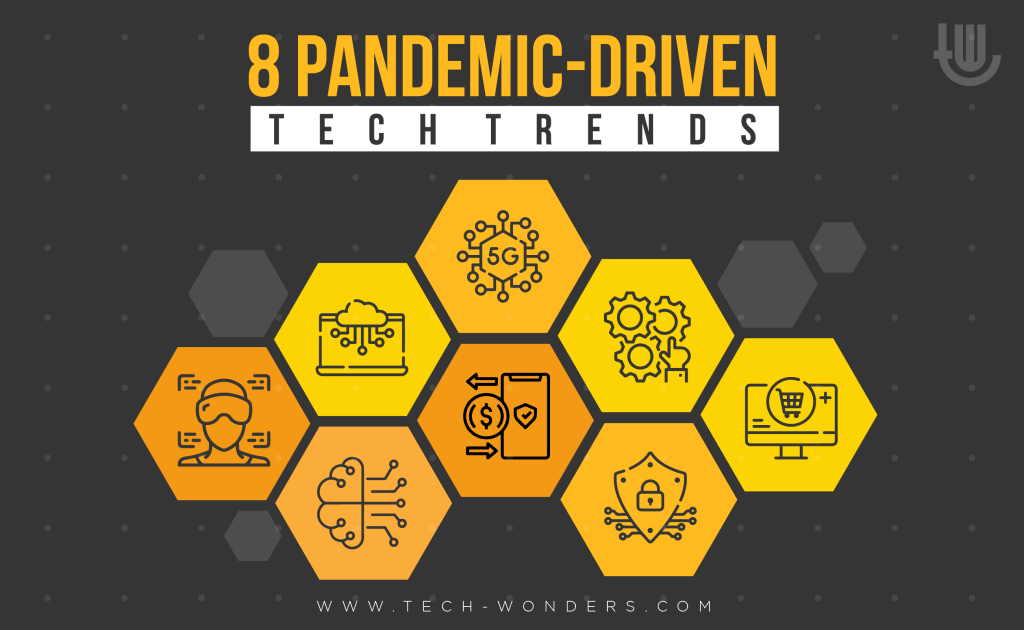
We’re currently witnessing an exciting episode of human history where a pandemic has accelerated the adoption of technology worldwide. From distance education to online payment – these technologies did exist before, but COVID helped them become widespread last year. These pandemic-driven trends won’t become obsolete in the future and will maintain relevancy in the post-coronavirus future. Studies have shown that COVID has helped people become more comfortable with digital solutions. For example, one study suggests that medium-sized businesses will continue growing their online presence when just 20% of them were digital before the pandemic. So, what trends have been massively accepted in 2020?
Tech trends adopted during the pandemic
The world experienced lockdowns and quarantines during the coronavirus pandemic that limited human interactions and restricted physical meetings. However, technology allowed humanity to maintain its fundamental operations during a global health crisis. While students continued their education digitally, employees resumed their functionalities via online portals. It seems as if the pandemic catalyzed the Fourth Industrial Revolution, and the world doesn’t seem willing to return to traditional strategies. So, these pandemic-driven digital trends are here to stay! These digital solutions increase productivity, hone social distancing, automate procedures, and make our lives safer/easier. Let’s review them, shall we?

Automation
Automation will remain an integral component of the business industry. Strengthened by COVID, the trend to increase the workforce’s productivity with AI shall become the “norm” in the future. We’ve seen examples such as self storage automation that bring customers more engagement and better reliability. It allows business owners to reduce staffing expenses, service non-English customers, and increase the security of their self-storage industry. Automation technologies will stay relevant now.Emotional Intelligence
Marketers are already utilizing “predictive emotional AI” to sense users’ sentiments to calculate what messages to show next. It’ll enable companies to display advertisements complementing their users’ feelings for better conversion rates. Reading the shoppers’ emotions will allow AI to influence their behaviors effectively. As people from various cultures respond differently to the same stimuli, AI can successfully interpret these signals. This technology will develop further after the pandemic.Cloud Services
The pandemic renewed the business industry’s interest in cloud services. With 90% of companies worldwide using the cloud, we’re observing an increasing demand for this technology during COVID. E-learning and telecommuting have encouraged students and employees to depend on the cloud for class teaching, team meetings, and information sharing. As an average person continues to produce information exponentially, it’s believed that the cloud computing industry will now cross $1,500 billion by 2030.VR/AR
Lockdowns made many people play video games using VR headsets and explore tourist destinations virtually to escape the pandemic-imposed isolation. This technology also enabled people to recreate social gatherings and tolerate social distancing.
Experts believe that VR/AR will boost the travel and entertainment industry. Business organizations can also utilize this technology to train workers and communicate with them virtually. Even after the pandemic is over, the world will keep using VR/AR.E-Commerce
Statistics show that e-commerce websites received more traffic in 2020 when lockdowns forced people to satisfy their shopping fantasies digitally. Consumers transformed the internet into an online market to purchase everything from groceries to electronics. E-commerce allows people to buy stuff effectively and comfortably without endangering their well-being. Companies introduced the “try before buy” concept where consumers experience 3D models of products before buying.Digital Payments
Social distancing has compelled people to accept cashless payment solutions that eliminate face-to-face interactions between two parties. The world was already universalizing contactless payments when COVID accelerated the transition. It restricts the circulation of contaminated banknotes while making transactions possible without the need for geographical proximity. This trend won’t become obsolete in the future. Instead, it will dominate the world’s monetary system for good.5G Networks
The world expects 5G networks to become the future of communication. Even though the pandemic made people uncertain about this technology, 5G offers better connectivity, faster downloads, and steadier connections. As social distancing seems to become the “norm” in the future, the world has started investing more heavily in 5G networks.
This technology can also support technologies that demand excellent connectivity, e.g., VUI (voice user interface) that replaces our physical connection with smartphones with a verbal one. It’s estimated that users touch their mobile gadgets 2,600+ times daily on average. As we continue to invest in 5G technology, our appliances can operate smoothly without being touched by us ever!Cybersecurity
Cybersecurity concerns increased during the pandemic, reports have discovered. Criminals started to target smaller companies, and protecting information became every business’s priority! Also, organizations accumulate more data than before, so preventing it from getting leaked has compelled business owners to invest in cybersecurity technologies. These software solutions deter criminals from accessing your systems and detect vulnerabilities in your systems. As companies allow workers to telecommute, these security measures will also become imperative for a company’s functionality. In the future, data sensitivity is expected to maintain cybersecurity as everyone’s primary concern.
Conclusion
How will the pandemic change our life as a species? A Pew Research survey from 2020 shows that nearly 50% of Americans expect their lifestyle to be changed drastically in the post-pandemic future. By bringing a surge in the adoption of technology, COVID-driven trends will continue reshaping our world.
From tech-driven fitness products and video conferencing to telehealth and cashless purchasing – these trends will remain relevant even after the pandemic’s over. Automation will become more involved in the business industry, and marketers will rely on VR to hone their campaigns. These digital solutions are doorways to the Fourth Industrial Revolution, brought closer by the coronavirus pandemic.